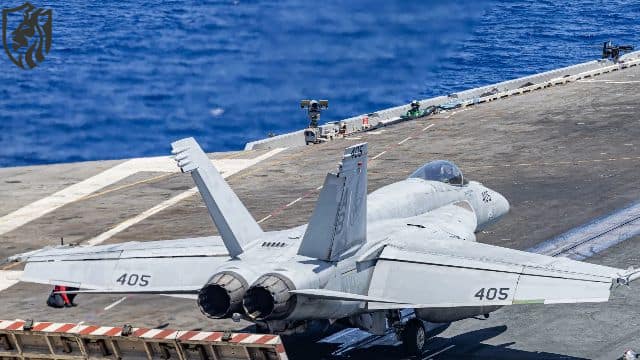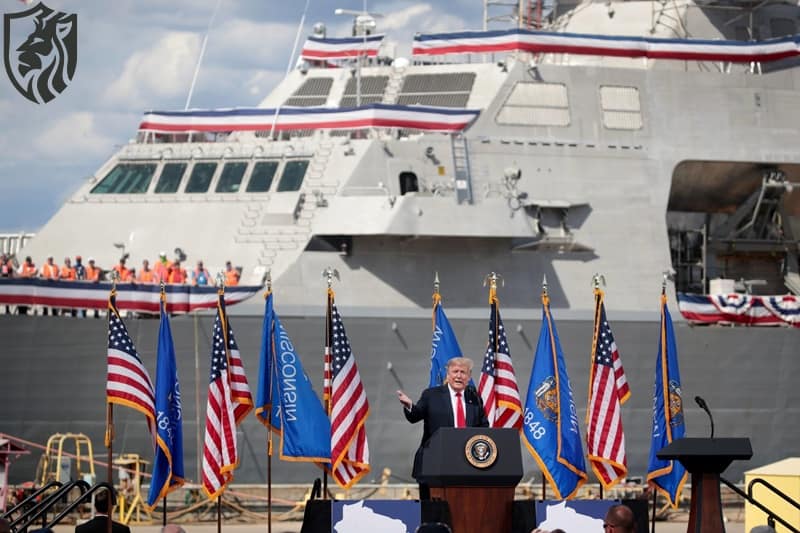
FA-18
A U.S. Navy F/A-18E Super Hornet, worth about $67.4 million, fell into the Red Sea from the deck of the USS Harry S. Truman aircraft carrier on April 28, 2025, while being towed in the ship’s hangar bay.
The incident happened when the carrier made a sharp turn to avoid a reported Houthi attack. Also lost overboard was a tow tractor. The accident shows how hard it is to operate for U.S. naval forces in the area.
There were no deaths reported, and only one sailor got hurt slightly, but the loss of the plane shows how difficult it is to keep up high-speed operations in a dangerous combat zone.
As the Navy looks into what happened, it raises questions about how long the current U.S. plans will work in the Red Sea, where Houthi rebels backed by Iran are still using drones and missiles to attack American warships.
The Nimitz-class aircraft carrier USS Harry S. Truman has been a key part of U.S. operations in the Middle East since it was sent there in September 2024.
Since the middle of March, the carrier has been attacking Houthi targets almost every day. It is in the Red Sea as part of Operation Prosperity Guardian, a global effort to protect maritime traffic.
Houthi Targets
In the past six weeks, the U.S. Central Command has hit over 800 Houthi targets, including weapons caches and command centers.
The Strike Fighter Squadron [VFA] 136 “Knighthawks” F/A-18E Super Hornet was being towed into the hangar bay when the crew lost control, letting the plane and tractor slide overboard.
Houthi threats likely caused the carrier’s evasive maneuver, according to a U.S. official who spoke with The War Zone. The Navy has confirmed the plane’s sinking, but recovery efforts remain unclear.

The F/A-18E Super Hornet is an important part of U.S. naval aviation. Boeing designed it as a multirole fighter capable of combating both air-to-air and air-to-ground targets.
The Super Hornet, which was made by Boeing, is an improvement over the earlier F/A-18 Hornet. The Super Hornet boasts a larger body, enhanced electronics, and increased cargo capacity.
60 · in length TTwo General Electric F404-GE-400/410 turbofan engines provide power to the plane. Each can produce up to 11,900 pounds of thrust, which lets it go faster than Mach 1.9.
Its advanced AN/APG-79 AESA radar is better at finding and following targets, and its glass cockpit has multifunction displays that make it easier to see what’s going on around you.
Red Sea
AIM-120 AMRAAM missiles, Joint Direct Attack Munitions (JDAM), and AGM-84 Harpoon anti-ship missiles are just some of the weapons that the F/A-18E can carry.
TThe Washington Post reports that each Super Hornet costs about $67.4 million. Its versatility makes it an important tool for projecting power, especially in contested areas like the Red Sea.
WWhen compared to other fighter jets around the world, the F/A-18E has better electronics and is more stealthy. TThe Super Hornet’s radar and sensors outperform those of Russia’s Su-35, which is a comparable fighter. The Su-35 can turn better and has a thrust-vectoring engine.
China’s J-15, which is a carrier-based version of the Su-27, isn’t as proficient at electronic warfare and has had trouble operating from carriers.
TThe Rafale-M is as versatile as the Super Hornet. However, it can only operate on the smaller Charles de Gaulle carrier, which limits the number of sorties it can make.
The Super Hornet has a big advantage when it comes to coordinated operations because it can connect to the U.S. Navy’s networked warfare systems, such as Link 16 datalinks and E-2D Hawkeye airborne early warning aircraft.
USS Harry S. Truman
Unfortunately, this is the latest setback for the USS Harry S. Truman while it is on deployment. In December 2024, the cruiser USS Gettysburg accidentally shot down an F/A-18F Super Hornet from the carrier. Both pilots were able to escape safely.
The Truman crashed into a merchant ship in February 2025 while working in an Egyptian port. As a result, Capt. Dave Snowden was fired as the ship’s commanding officer. The carrier was fixed up at a U.S. Navy base in Greece before returning to the Red Sea.
The problems that led to the loss of the F/A-18E show how hard it is to keep fighting in an area where Houthi forces have attacked U.S. warships at least 174 times since 2023, according to numbers from the White House that were reported by Breitbart.
The Houthi rebels’ struggle against maritime traffic has transformed the Red Sea into a focal point in the wider Middle East conflict. Since the Houthis were responsible for most of northern Yemen, they started attacking ships in late 2023, saying they were standing with Palestinians during Israel’s war in Gaza.
The Defence Post
With help from Iran, the Houthis have many weapons—ballistic missiles, cruise missiles, and kamikaze drones. They use these for complex, high-volume attacks designed to overwhelm defenses.
Although the Houthis have not hit any U.S. warships, the threat has compelled commercial ships to steer clear of the Red Sea. Many now sail around southern Africa, as The Defence Post reported.
The Houthis claimed they attacked the USS Truman with drones and missiles on that day. The Navy’s statement didn’t confirm the attack caused the F/A-18’s loss.
In response, Truman’s Carrier Air Wing 1 has used standoff weapons like the AGM-154C and SLAM-ER. This marks a shift away from heavier bombs like the 1,000-pound GBU-32 JDAM.
The Truman operates with three guided-missile destroyers and the cruiser USS Gettysburg. The Navy says this carrier strike group remains fully mission-capable despite the incident.
The United States continues to exert pressure on the Houthis, as evidenced by the deployment of the USS Carl Vinson, armed with F-35Cs. Since March 15, 2025, U.S. strikes on Houthi targets have increased. President Trump vowed “overwhelming lethal force” that day, according to The Washington Post.
ABC News
Truman’s crew faces intense operational pressure in the Red Sea. They must keep aircraft flight-ready, conduct missions, and respond quickly to emerging threats. Towing planes in hangars is routine but dangerous. Limited space and ship movement make it especially risky.
A defense official told ABC News that the crew lost control of the plane during towing. Sailors jumped clear, preventing more damage or injuries.
This accident mirrors a 2022 incident when an F-35C crashed while landing on the USS Carl Vinson. The incident injured seven sailors and resulted in high recovery costs.
Such accidents are rare, but they highlight the challenges of operating advanced jets in harsh environments. Carriers have long projected U.S. power worldwide.
During the 1991 Gulf War, they flew thousands of missions. The USS Carl Vinson led early strikes in Afghanistan in 2001 during Operation Enduring Freedom.
Nimitz-class carriers like the Truman weigh nearly 100,000 tonnes and carry over 60 aircraft. They can launch up to 150 sorties daily. Their nuclear propulsion lets them stay at sea for long periods.
Black Sea
But the Red Sea’s shallow waters and narrow geography increase vulnerability to shore-based attacks. Houthis use asymmetric tactics—cheap mass strikes—to counter high-tech U.S. platforms like the Super Hornet. The Institute for the Study of War reported multiple Houthi attacks on the Truman in one day.
Despite U.S. airstrikes, Houthi operations continue, thanks to Iran’s support and missile training. Similar trends appear elsewhere. Ukrainian drones have struck Russian ships in the Black Sea with surprising success.
The cost gap is striking. A Super Hornet costs $67.4 million, while Houthi drones cost only thousands. This contrast raises tough questions about the long-term value of carrier-based strategies.

The Truman’s crew is under even more stress because of the complicated political situation in the area. Newsweek says that the Houthis’ actions are linked to the conflict in Gaza, which has made people in Yemen more against the United States and led to large-scale protests.
American Drones
The Houthis’ ability to shoot down U.S. MQ-9 Reaper drones and their missile attacks on Israel demonstrate that they pose a threat in multiple areas, which reduces the effectiveness of U.S. defenses.
The U.S. response aims to weaken the Houthis’ power by hitting their leaders and imposing sanctions on their fuel networks, but the rebels’ ability to adapt and Iran’s support make the goal harder to achieve.
Newsweek reports that Defense Secretary Pete Hegseth, who is being questioned about alleged leaks, defended the intensity of the campaign by saying, “We’re not going to give up until the Houthis stop shooting at our ships.”
The loss of the F/A-18E also impacts the United States. People may pay even more attention to defense spending, which is already a controversial topic, if critics question how much these kinds of events cost.
Priorities like healthcare and building up the country’s infrastructure are in the way of the Navy’s $716 billion budget request for 2025. The request includes money for maintaining aircraft carriers and buying new planes.
Conclusion
In the past, accidents like the 2017 USS Fitzgerald collision led to hearings in Congress about readiness. The recent problems with the USS Truman could lead to similar oversight. Focusing on mission capability is part of the Navy’s plan to reassure stakeholders, but these incidents could hurt trust in operational discipline over time.
The Navy’s investigation will likely examine procedural errors, equipment reliability, and the impact of the carrier’s evasive maneuvers. Past accidents could lead to improved towing procedures or better awareness tools for future operations.
Red Sea conditions may push investment into counter-drone technology, like laser defenses or unmanned systems, to protect crewed aircraft. The bigger question remains: are aircraft carriers still the best choice for high-risk coastal zones?
Emerging threats like hypersonic missiles and drone swarms may force a rethink of traditional naval strategies. These changes could reshape the cost and value of carrier-based operations going forward.
Losing the F/A-18E Super Hornet is more than just a terrible accident that cost a lot of money. Pressures impact modern naval warfare. The crew of the USS Harry S. Truman works at the limits of what humans and machines can handle, facing an enemy that thrives on chaos.
The Red Sea used to be an important trade route, but now it’s a place where asymmetric threats can show how dangerous they are to U.S. dominance.
As the Navy changes, the event brings up a serious question: can the US keep its carrier-based model in a time when battlefields are becoming more agile and cost-effective? The answer could change the Red Sea campaign and how the US projects power in the future.
References
- The War Zone—Houthi Threat Behind USS Truman Maneuver
- The Washington Post—Navy Confirms Super Hornet Loss
- The Defense Post – Red Sea Shipping Reroutes
- ABC News—Navy Official on Towing Accident
- Breitbart – Houthi Attack Statistics
- Newsweek—Gaza Conflict and Yemen Unrest
- Institute for the Study of War – Houthi Tactics
- U.S. Central Command – Operation Updates
- Boeing – F/A-18E Super Hornet Specifications
- U.S. Navy – USS Harry S. Truman Information








